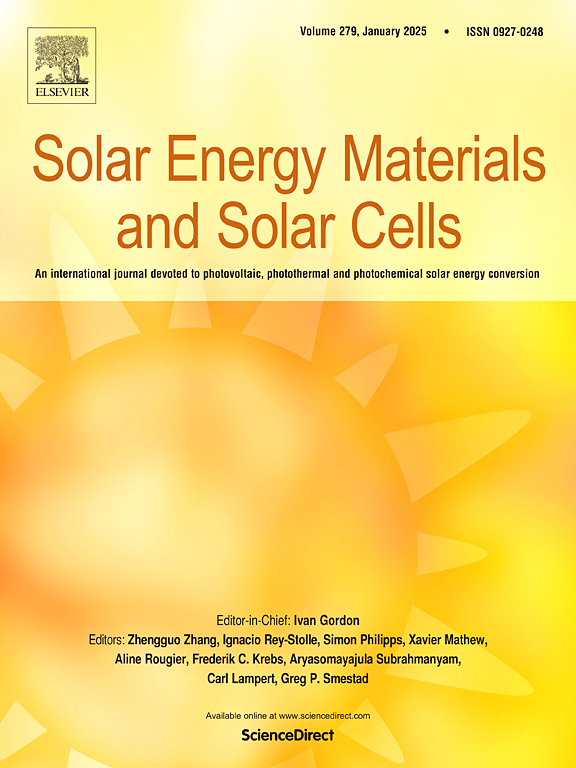ELO-compatible back reflectors for light management in thin-film GaAs-based LEDs
IF 6.3
2区 材料科学
Q2 ENERGY & FUELS
引用次数: 0
Abstract
With the advent of thermophotonics, interest in GaAs-based light-emitting diodes (LEDs) has recently reignited due to their potential in energy conversion applications, including the demonstration of electroluminescent cooling (ELC). To that end, the light extraction efficiency of these devices should ultimately approach unity to achieve the necessary high external quantum efficiency. This work therefore evaluates various back reflector designs on GaAs/InGaP shifted double heterojunction LEDs produced by epitaxial lift-off (ELO), targeting reduced back-side losses and improved front-side light extraction. Through optical and electrical characterization of the LEDs, the optimal back reflector design in this work was found to combine a texturing technique previously employed in ultra-thin GaAs solar cells with an omnidirectional reflector based on ZnS and Ag. This approach yields an approximately twofold enhancement in external quantum efficiency compared to a planar Ag reflector, corresponding to a tenfold improvement over comparable substrate-based LEDs. These enhancements are thoroughly analyzed in terms of the probabilities of escape and reabsorption, calculated using our in-house developed Photon Dynamics model. This model suggests that a further fourfold enhancement could be achieved by integrating a high-refractive index ZnSe dome, optimizing the rear-side dielectric, and improving the haze in reflection of the textured reflector. Beyond the potential for GaAs-based LEDs in demonstrating ELC, these advancements contribute to the broader development of thermophotonic energy conversion systems. Additionally, the presented ELO-compatible textured omnidirectional reflector offers broad applicability to III-V optoelectronic devices, including LEDs for the lighting and display industry, thermophotovoltaic devices, and ultra-thin solar cells.

用于薄膜gaas基led光管理的elo兼容背反射器
随着热光子学的出现,对gaas基发光二极管(led)的兴趣最近重新燃起,因为它们在能量转换应用中的潜力,包括电致发光冷却(ELC)的演示。为此,这些器件的光提取效率最终应趋于一致,以达到必要的高外量子效率。因此,本研究评估了由外延提升(ELO)生产的GaAs/InGaP移位双异质结led的各种后向反射器设计,旨在减少背面损耗和改善正面光提取。通过对led的光学和电学表征,发现本研究中最优的背反射器设计是将超薄砷化镓太阳能电池中使用的纹理技术与基于ZnS和Ag的全向反射器相结合。与平面Ag反射器相比,这种方法在外部量子效率上提高了大约两倍,相当于比基于衬底的led提高了十倍。根据逃逸和重吸收的概率对这些增强进行了彻底的分析,使用我们内部开发的光子动力学模型进行了计算。该模型表明,通过集成高折射率的ZnSe圆顶、优化后侧电介质以及改善纹理反射器的反射雾霾,可以实现进一步的四倍增强。除了基于gaas的led在展示ELC方面的潜力之外,这些进步有助于热光子能量转换系统的更广泛发展。此外,所提出的elo兼容纹理全向反射器可广泛适用于III-V光电子设备,包括用于照明和显示行业的led,热光伏设备和超薄太阳能电池。
本文章由计算机程序翻译,如有差异,请以英文原文为准。
求助全文
约1分钟内获得全文
求助全文
来源期刊

Solar Energy Materials and Solar Cells
工程技术-材料科学:综合
CiteScore
12.60
自引率
11.60%
发文量
513
审稿时长
47 days
期刊介绍:
Solar Energy Materials & Solar Cells is intended as a vehicle for the dissemination of research results on materials science and technology related to photovoltaic, photothermal and photoelectrochemical solar energy conversion. Materials science is taken in the broadest possible sense and encompasses physics, chemistry, optics, materials fabrication and analysis for all types of materials.
 求助内容:
求助内容: 应助结果提醒方式:
应助结果提醒方式:


